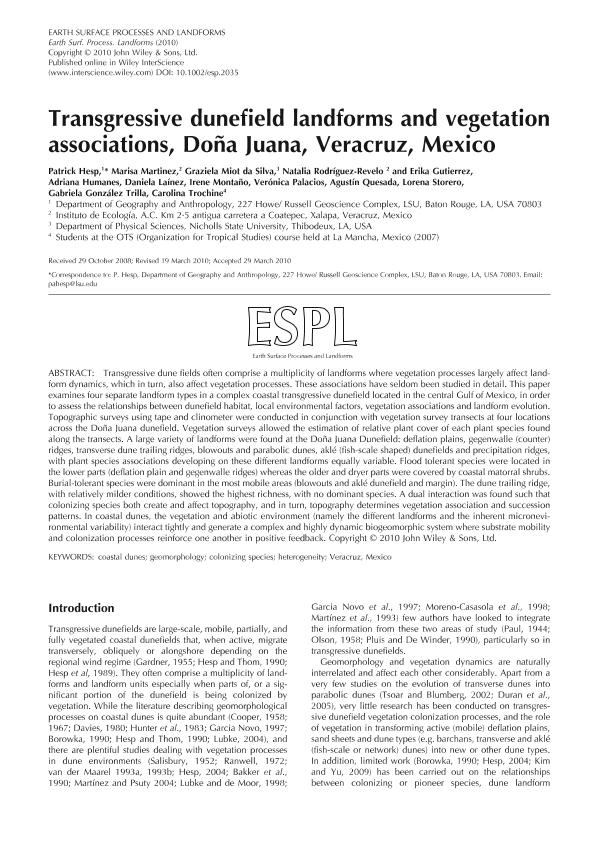Artículo
Transgressive dunefield landforms and vegetation associations, Doña Juana, Veracruz, Mexico
Hesp, Patrick; Martinez, Marisa; Miot da Silva, Graziela; Rodríguez Revelo, Natalia; Gutierrez, Erika; Humanes, Adriana; Laínez, Daniela; Montaño, Irene; Palacios, Verónica; Quesada, Agustín; Storero, Lorena Pia ; Gonzalez Trilla, Gabriela Liliana
; Gonzalez Trilla, Gabriela Liliana ; Trochine, Carolina
; Trochine, Carolina
 ; Gonzalez Trilla, Gabriela Liliana
; Gonzalez Trilla, Gabriela Liliana ; Trochine, Carolina
; Trochine, Carolina
Fecha de publicación:
03/2011
Editorial:
John Wiley & Sons Ltd
Revista:
Earth Surface Processes And Landforms
ISSN:
0197-9337
e-ISSN:
1096-9837
Idioma:
Inglés
Tipo de recurso:
Artículo publicado
Clasificación temática:
Resumen
Transgressive dune fields often comprise a multiplicity of landforms where vegetation processes largely affect landform dynamics, which in turn, also affect vegetation processes. These associations have seldom been studied in detail. This paper examines four separate landform types in a complex coastal transgressive dunefield located in the central Gulf of Mexico, in order to assess the relationships between dunefield habitat, local environmental factors, vegetation associations and landform evolution. Topographic surveys using tape and clinometer were conducted in conjunction with vegetation survey transects at four locations across the Doña Juana dunefield. Vegetation surveys allowed the estimation of relative plant cover of each plant species found along the transects. A large variety of landforms were found at the Doña Juana Dunefield: deflation plains, gegenwalle (counter) ridges, transverse dune trailing ridges, blowouts and parabolic dunes, aklé (fish-scale shaped) dunefields and precipitation ridges, with plant species associations developing on these different landforms equally variable. Flood tolerant species were located in the lower parts (deflation plain and gegenwalle ridges) whereas the older and dryer parts were covered by coastal matorral shrubs. Burial-tolerant species were dominant in the most mobile areas (blowouts and aklé dunefield and margin). The dune trailing ridge, with relatively milder conditions, showed the highest richness, with no dominant species. A dual interaction was found such that colonizing species both create and affect topography, and in turn, topography determines vegetation association and succession patterns. In coastal dunes, the vegetation and abiotic environment (namely the different landforms and the inherent micronevironmental variability) interact tightly and generate a complex and highly dynamic biogeomorphic system where substrate mobility and colonization processes reinforce one another in positive feedback.
Palabras clave:
COASTAL DUNES
,
GEOMORPHOLOGY
,
COLONIZING SPECIES
,
HETEROGENEITY
,
VERACRUZ
,
MEXICO
Archivos asociados
Licencia
Identificadores
Colecciones
Articulos(IIMYC)
Articulos de INSTITUTO DE INVESTIGACIONES MARINAS Y COSTERAS
Articulos de INSTITUTO DE INVESTIGACIONES MARINAS Y COSTERAS
Articulos(INIBIOMA)
Articulos de INST. DE INVEST.EN BIODIVERSIDAD Y MEDIOAMBIENTE
Articulos de INST. DE INVEST.EN BIODIVERSIDAD Y MEDIOAMBIENTE
Citación
Hesp, Patrick; Martinez, Marisa; Miot da Silva, Graziela; Rodríguez Revelo, Natalia; Gutierrez, Erika; et al.; Transgressive dunefield landforms and vegetation associations, Doña Juana, Veracruz, Mexico; John Wiley & Sons Ltd; Earth Surface Processes And Landforms; 36; 3; 3-2011; 285-295
Compartir
Altmétricas



